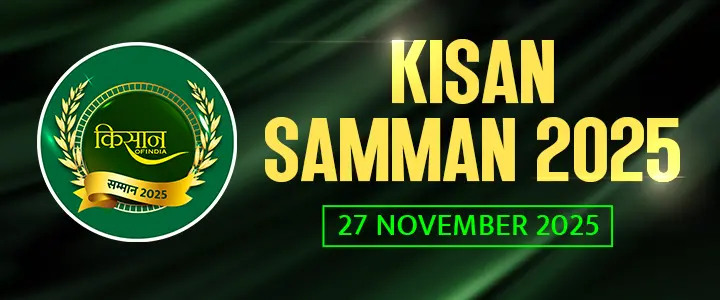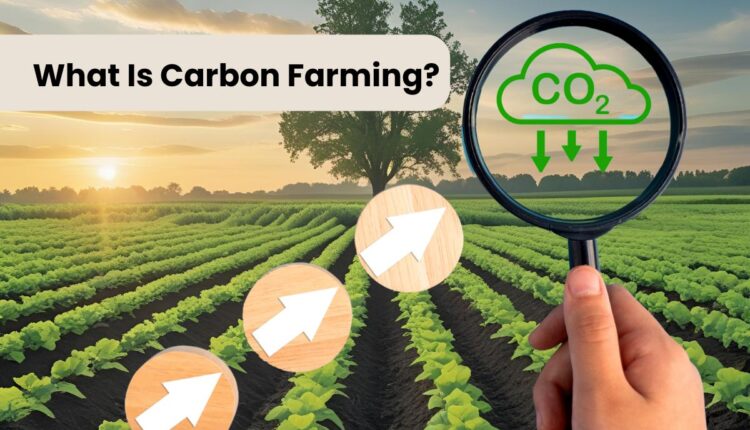Carbon Farming in India: In today’s world, the words climate change and carbon emissions are everywhere — from the news to government policies. But what does it mean for Indian farmers? Surprisingly, it could mean new income opportunities. With the rise of carbon farming, small and marginal farmers can play a big role in fighting climate change and even earn money for it. Let’s break it down in simple terms.
What Is Carbon Farming?
Carbon farming means using agricultural practices that capture and store (or “sequester”) carbon dioxide (CO₂) from the atmosphere. Plants naturally pull CO₂ from the air as they grow. Some farming methods help lock this carbon in the soil or trees, reducing greenhouse gases.
Examples include:
– Planting cover crops (like legumes or grasses)
– Practicing agroforestry (growing trees alongside crops)
– Improving soil health with organic methods
– Using minimum tillage to disturb the soil less
By doing this, farmers trap carbon in the ground instead of letting it escape back into the atmosphere.
The Science Behind Carbon Sequestration
Here’s how it works:
• Plants absorb CO₂ during photosynthesis.
Some carbon is used by the plant, and some is stored in roots or organic matter.
When crops die or leaves fall, this biomass becomes part of the soil.
• Healthy soils rich in organic matter can hold tons of carbon per hectare.
Practices like adding compost, using mulches, reducing chemical fertilizers, and planting perennial species improve the soil’s ability to retain carbon for years.
Why Is Carbon Farming Important Globally?
Globally, agriculture contributes about 25% of greenhouse gas emissions. But it also holds huge potential to reverse some of that damage.
International agreements like the Paris Climate Agreement and global net-zero targets have created strong demand for carbon removal. Companies and governments are paying farmers and landowners worldwide to store carbon — this is where carbon credits come in.
What Are Carbon Credits?
Imagine this – For every 1 ton of CO₂ a farmer’s land removes or avoids emitting, they can generate 1 carbon credit. These credits are sold in carbon markets to companies or countries that need to “offset” their own emissions. For example, a company that can’t reduce all its factory emissions might buy credits from farmers or forest owners to meet climate goals. Prices vary globally, but credits can sell between $5 and $30 per ton, depending on the project, location, and quality.
How Can Indian Farmers Get Involved?
Many small farmers in India may ask themselves,
“Can I really take part in global carbon markets with my small farm?”
The good news is: Yes, you can — but there are some important steps to follow.
Let’s break it down simply:
– Adopt Carbon-Sequestering Practices
First, farmers need to use farming methods that help capture and store carbon in the soil and plants.
This includes:
• No-till farming (reducing how much you disturb the soil)
Adding compost or using biochar to enrich the soil
Planting trees or shrubs on farmland (also called agroforestry)
Growing cover crops between main crop seasons to keep the soil covered and healthy
• Better grazing practices if you have livestock, so the grassland stays strong
These practices are carefully measured to see how much carbon they can store. The more carbon stored, the more credits a farm can earn.
– Work with Aggregators or Cooperatives
Most small farmers cannot do this alone.
Why? Because:
Small farms don’t produce enough carbon savings to sell on their own.
• It costs too much to handle the monitoring, paperwork, and certification by themselves.
This is why joining farmer groups, cooperatives, NGOs, or aggregator companies is important.
When many farmers come together:
• It reduces the cost for each person.
• It creates a large project that can attract buyers in carbon markets.
It helps with proper certification and management, which farmers might not be able to do alone.
– Get Verified and Certified
To sell carbon credits, your farming practices need to be officially verified and certified.
Some of the main certification programs are:
• Verra (VCS)
Gold Standard
• Indian government schemes (which are being developed)
Verification means:
• The carbon being stored is real and measurable.
The carbon stays locked in for the long term.
• The system avoids double counting, so no two people claim the same credit.
Without certification, the carbon credits cannot be sold in formal markets.
– Sell the Credits
Once your project is verified, you can sell the carbon credits in two types of markets:
• Voluntary markets — where companies choose to buy credits to reduce their carbon footprint.
Compliance markets — where countries or companies are required by law to offset a certain amount of emissions.
Farmers can get paid:
• For each ton of carbon stored.
- Or as a share of the overall project income, depending on how the group agreement is set up.
Examples of Carbon Farming Practices in India
Let’s look at some India-specific examples:
Agroforestry
Integrating trees like neem, mango, moringa, or timber species on farmland.
• Benefits: Shade, fodder, timber, biodiversity, AND carbon capture.
Cover Cropping
• Planting nitrogen-fixing legumes (like moong, urad) between crop cycles.
• Benefits: Improves soil, reduces weeds, adds organic matter, boosts carbon.
Soil Health Practices
• Applying compost or manure, reducing chemical fertilizers.
Using minimal or zero tillage.
• Benefits: Builds up carbon-rich soil, improves water retention, enhances fertility.
Improved Grazing Management
• Rotational grazing to avoid overgrazing.
• Benefits: Grasslands store more carbon, livestock health improves.
Challenges for Indian Small Farmers
While carbon farming offers great promise, Indian small farmers face several challenges that need attention.
Small Landholdings
Most farmers in India own less than 2 hectares of land. This makes it hard for them to start carbon projects on their own. A small piece of land does not capture enough carbon to generate valuable credits, and managing the process independently is often not practical.
Upfront Investment
Some carbon-friendly practices, such as planting trees or setting up agroforestry systems, require money at the start. Farmers need to buy seedlings, prepare the land, and wait several years before the trees grow enough to store significant carbon. This waiting period demands patience and financial support, which many small farmers may find difficult.
Knowledge Gaps
Many farmers are not fully aware of what carbon markets are or how they work. They may not know which farming practices qualify for carbon credits or how to measure the carbon stored on their land. Without proper knowledge and guidance, they cannot easily take part in carbon farming projects.
Verification Complexity
To sell carbon credits, farmers must get their projects certified, which is not a simple process. Certification requires careful scientific measurement, sometimes using satellite images or soil tests, and involves keeping records and completing paperwork. For small farmers, managing these technical and administrative tasks can be very challenging without outside help.
Role of the Indian Government and NGOs
For carbon farming to succeed among small farmers, institutional support is crucial.
Government Support
• Subsidies or incentives for agroforestry, composting, or biochar.
Integration into government schemes like MGNREGA for land restoration.
• Development of Indian carbon registries to simplify access.
NGO and Private Sector Involvement
• NGOs can educate farmers and aggregate land.
• Companies can invest in pilot projects and help farmers enter markets.
Research and Innovation
• Indian agricultural research institutes (ICAR, ICRISAT) can develop region-specific carbon practices.
• Digital tools (apps, satellite tracking) can simplify monitoring.
Potential Earnings: How Much Can Farmers Make?
Here’s an illustrative estimate (varies by practice and region):
| Practice | Estimated Carbon Sequestered (per hectare/year) | Potential Earnings (₹) |
| Agroforestry | 5–10 tons CO₂ | ₹4,000–₹24,000/year |
| Cover Cropping | 1–2 tons CO₂ | ₹800–₹4,000/year |
| Soil Improvement | 1–3 tons CO₂ | ₹800–₹6,000/year |
Remember:
• This is extra income, on top of regular farming.
• Earnings depend on carbon credit prices, verification costs, and market demand.
Global Examples to Learn From
There are several countries around the world where small farmers are already benefiting from carbon farming projects.
For example, in Kenya, many smallholder farmers are part of agroforestry projects where they plant trees alongside their crops to store carbon and improve their land. In Peru, carbon credits are being generated from the protection of the Amazon rainforest, where local communities help conserve forests and receive income in return. In Australia, farmers on grazing lands are improving soil health and earning soil carbon credits.
We can also look at Vietnam, where small farmers are combining rice farming with fish farming (integrated systems) to reduce methane emissions and improve carbon capture. In Rwanda, farmers are part of land restoration projects that improve degraded lands and generate carbon credits. And in Nepal, community forest groups are preserving mountain forests and earning carbon credits that support both livelihoods and conservation.
These examples show that small farms and communities can successfully participate in carbon markets — but only when they have good partnerships, technical support, and local cooperation. Indian farmers can learn valuable lessons from these international models.
Can Carbon Farming Work for India’s Small Farmers?
For Indian small farmers, the journey to carbon markets requires teamwork, training, and support. Carbon farming offers a long-term opportunity like fight climate change, improve soil and farm resilience and generate an extra stream of income.
But with the right practices and partnerships, farmers can not only help fight climate change but also open a new source of income for their families.
If done right, India’s 100 million small and marginal farmers can become climate heroes — protecting the planet while strengthening their own livelihoods.
Contact us- If farmers want to share any valuable information or experiences related to farming, they can connect with us via phone or whatsApp at 9599273766 or you can write to us at [email protected]. Through Kisan of India, we will convey your message to the people, because we believe that if the farmers are advanced then the country is happy.
You can connect with Kisan of India on Facebook, Twitter, and WhatsApp and Subscribe to our YouTube channel.



